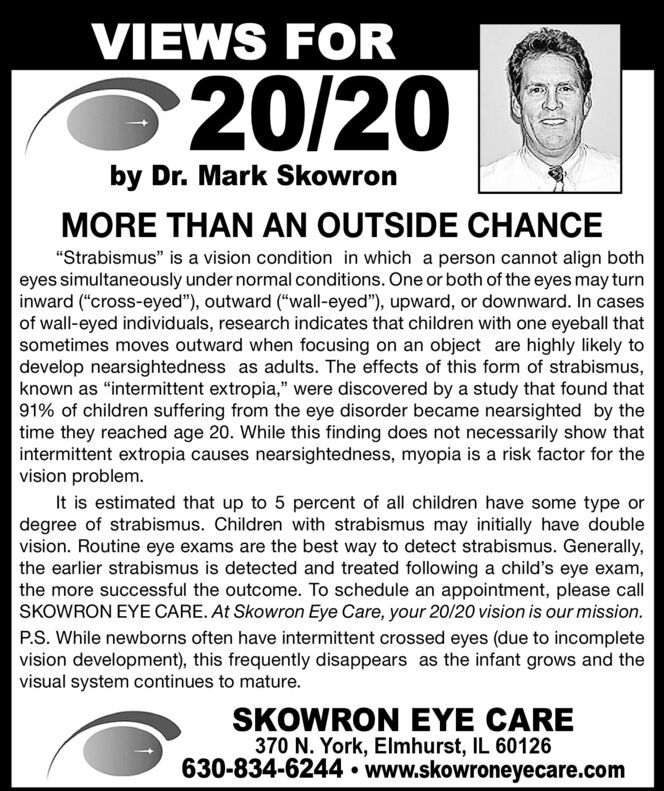Advertisement

-
Published Date
June 10, 2021This ad was originally published on this date and may contain an offer that is no longer valid. To learn more about this business and its most recent offers, click here.
Ad Text
VIEWS FOR 20/20 by Dr. Mark Skowron MORE THAN AN OUTSIDE CHANCE "Strabismus" is a vision condition in which a person cannot align both eyes simultaneously under normal conditions. One or both of the eyes may turn inward ("cross-eyed"), outward ("wall-eyed"), upward, or downward. In cases of wall-eyed individuals, research indicates that children with one eyeball that sometimes moves outward when focusing on an object are highly likely to develop nearsightedness as adults. The effects of this form of strabismus, known as "intermittent extropia," were discovered by a study that found that 91% of children suffering from the eye disorder became nearsighted by the time they reached age 20. While this finding does not necessarily show that intermittent extropia causes nearsightedness, myopia is a risk factor for the vision problem. It is estimated that up to 5 percent of all children have some type or degree of strabismus. Children with strabismus may initially have double vision. Routine eye exams are the best way to detect strabismus. Generally, the earlier strabismus is detected and treated following a child's eye exam, the more successful the outcome. To schedule an appointment, please call SKOWRON EYE CARE. At Skowron Eye Care, your 20/20 vision is our mission. P.S. While newborns often have intermittent crossed eyes (due to incomplete vision development), this frequently disappears as the infant grows and the visual system continues to mature. SKOWRON EYE CARE 370 N. York, Elmhurst, IL 60126 630-834-6244 www.skowroneyecare.com VIEWS FOR 20/20 by Dr. Mark Skowron MORE THAN AN OUTSIDE CHANCE "Strabismus" is a vision condition in which a person cannot align both eyes simultaneously under normal conditions. One or both of the eyes may turn inward ("cross-eyed"), outward ("wall-eyed"), upward, or downward. In cases of wall-eyed individuals, research indicates that children with one eyeball that sometimes moves outward when focusing on an object are highly likely to develop nearsightedness as adults. The effects of this form of strabismus, known as "intermittent extropia," were discovered by a study that found that 91% of children suffering from the eye disorder became nearsighted by the time they reached age 20. While this finding does not necessarily show that intermittent extropia causes nearsightedness, myopia is a risk factor for the vision problem. It is estimated that up to 5 percent of all children have some type or degree of strabismus. Children with strabismus may initially have double vision. Routine eye exams are the best way to detect strabismus. Generally, the earlier strabismus is detected and treated following a child's eye exam, the more successful the outcome. To schedule an appointment, please call SKOWRON EYE CARE. At Skowron Eye Care, your 20/20 vision is our mission. P.S. While newborns often have intermittent crossed eyes (due to incomplete vision development), this frequently disappears as the infant grows and the visual system continues to mature. SKOWRON EYE CARE 370 N. York, Elmhurst, IL 60126 630-834-6244 www.skowroneyecare.com
